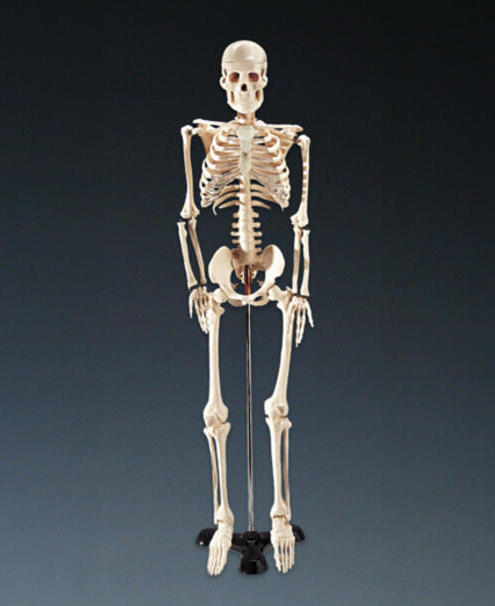
Story: Zoe Dances With Death
A story about anatomy, preschoolers, and the things that bones can’t teach. Written a century ago, and recently reworked for posting here.
Zoe Dances With Death
I’m watching, with some concern, as my three-year old, Zoe, dances with death. She spins the specter madly in her arms, and he is losing bones at an alarming rate. Already, he is missing his left hand, the cap of his skull, his entire right arm, and assorted minor skeletal features. “Daddy!” she cries, “His knee cap came off!”
Reputation aside, Death is no match for the affections of a pre-schooler.
Yes, death had come to our house, but with no dark purpose. On the contrary, he was sharing a room with my little ballerina and went by the name of Mr. Thrifty. A plastic skeleton made for the medical student on a budget, Mr. Thrifty was given to me by my wife at a time when I had a growing interested in human anatomy. He was precisely as tall as my daughter, and when she asked him to dance, she called him “Mr. Thrift-i-ty”. …

Mr. Thrifty was never the picture of health, but his pitiable physical condition was complicated by the year-long exile he served in a metal storage-container in the California desert, while the young Zoe and her parents served an exile of their own in Cambridge, England. When the doors of his iron tomb were opened (made more dramatic by my inability to produce a key, requiring a forced-entry by blowtorch), Mr. Thrifty appeared (through the smoke) a bit warped around the rib-section, and bent in the legs. The entire effect of this heat-induced disease is pathetic. He could no longer stand straight and his head (such as it was) always hung to the side on a scoliotic spine. But the love of my daughter was unconditional. She’d cradle him in her arms and coo to him: “Poor Mr. Thrift-i-ty!” …
I began dropping hints to my daughter that Mr. Thrifty was very sick- a weak attempt on my part to prepare her for his return to dust, or plastic pellets, or whatever. (Maybe, I thought, we could have him recycled into a fleece jacket. Im sure Mr. Thrifty, having spent his entire life without insulation, would appreciate bringing warmth to another.)
One day, I came home to find my daughter lying on her bed, reading a book, while under the bed directly beneath her and in a similar position, lay Mr. Thrifty. My mind went back to a memorial I had seen in England which presented a glorified likeness of the deceased on a pallet above, and a skeleton below, all carved in stone. Seeing my daughter in this grave context had a strange effect on me. This skeleton, after all, if not for the adult features discernible by the student of anatomy, could be mistaken for the remains of a friend of hers after a bad play-date. As a father, I wondered how appropriate it was for my daughter and a skeleton to spend time together, let alone dance.
I mean, what would the neighbors say about such mixed company shenanigans? There’s no question we Americans don’t like death, or anything that reminds us of death. We don’t like sickness, we don’t like grief. We certainly don’t like any condition at all that results in “skeleton”. We are the people, after all, who renamed the parlor in our homes to better reflect our optimism and break any association with a room where funerals take place, choosing instead to gather in the living room. A plastic child-sized skeleton might send the wrong message.
But Zoe learned a lot from having Mr. Thrifty around. She knew at a surprisingly young age that she was made of bone, muscle, and blood. She knew that her bones make her able to stand, her muscles make her able to move, and her blood goes all around in her body bringing food to her muscles. But I wonder. … Here it is: I wonder if on some level she also understands that, one day, she will end up like Mr. Thrifty: bent, broken, powerless to move on her own?
Ok, maybe three-years-old is a mite young for a lesson about such things. And anyway there’s more to learn about us than just this. Mr. Thrifty can only teach so much. I want to teach my daughter that she is more than bones, that there is more than blood that “goes all around” inside her.
But while bones are easy to see and easy enough to teach, there are parts and places within us that are harder to find words for.
Henry Vaughn in the fifteenth century wrote of one who
Felt through all this fleshly dress
Bright shoots of everlastingness
That’s right. That’s the hope we feel—yes—even in our bones: a bright shot of everlastingness. It’s this God-shot that “goes all around” in each of us, calling out to us from the deeps, calling out to us to come free. We hear the call, as though from a distance, while we wait out our exile from inside the bounds of our bony prisons. And even as we bend and twist in fury at the end, and say goodbye to some of our better parts, the call repeats, and marks a better time, extending to us that grace that also, coincidentally, goes by the name of Zoe.
And she cradles us in her arms, speaks gently to us, and, with a bow, invites us to join the dance.